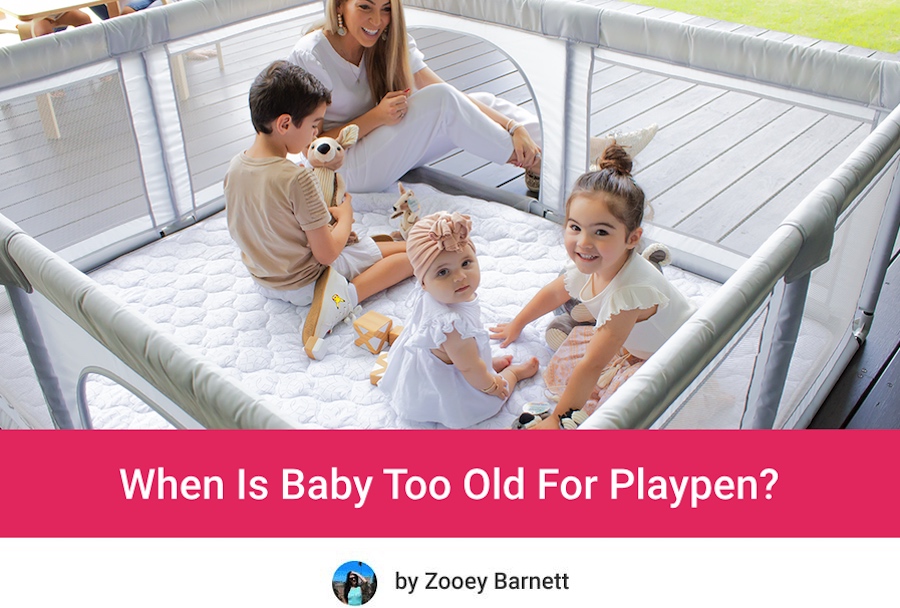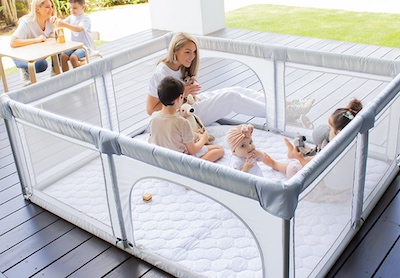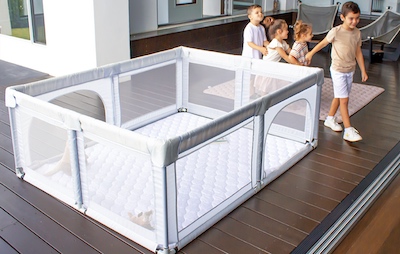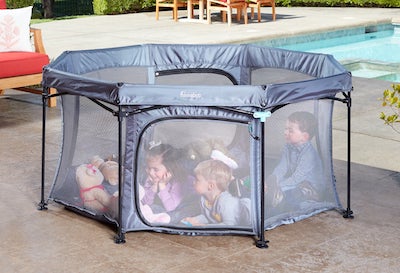
Like many new parents, you may be wading through the many baby products advertised online at at baby stores and wondering which ones are truly essentials and which are just hyped-up.
Like playpens: are they really necessary? And how long can babies us a playpen, anyway?
Things for babies safety and babies sleep (like swaddles, a crib and sleep sacks) are essentials. Things for baby play, are not. However, that doesn’t mean you shouldn’t consider some of these helpful items of baby gear – some parents swear by baby bouncers and playpens, it’s all about if you have the space and budget for them.
Some parents use a playpen (the fence or panel style pens that can expand and make different shapes) well past the baby years, even through age six for both indoor and outdoor play.
Although playpens are not essentials, if you have the space for one, you may just love the freedom it gives you and your growing baby.
This article is not a substitute for medical advice or consultation.
What Is Playpen?
A playpen is an enclosed area for safe baby play. They usually have short, sturdy walls and are made of plastic or wood. Some have a base, while others stand on the floor and can expand in size, or made different shapes depending on how many panels you connect.
A play pen is not a pack-n-play.
Just to be clear, a playpen is not a pack-n-play or travel cot for babies. This is a different thing, and it is not advised that your baby sleep in a playpen (on the other hand, travel cots ARE specifically designed for baby naps).
A playpen is generally bigger and sturdier than a pack-n-play, some large enough to fit play mats and several children at once.
Playpen is perfect for crawling baby, because it’s an enclosed area so it will keep your little explorer secured.

Benefits Of Playpens And Play Yards
-
Baby’s Safety
The best part of a playpen is that it is a safe environment for babies.
Once baby stars sitting up on their own, they can play in a playpen. Once a baby starts crawling, you may NEED to put them in a playpen, just to keep them in a safe, enclosed area while you rush to the toilet or answer the door.
Now, a playpen doesn’t have to be your only approach to keep children safe; as your baby grows, you’ll likely need to make your entire home a safe place and ‘baby-proof’ major living areas, such as the sitting room and their nursery.
If you have a small home or apartment, you may not ever need a playpen with your baby. Just set up a play mat on the floor and keep dangerous or breakable objects off lower shelves for the first few years.
However, if you do have the space, a playpen can give you some peace of mind to leave your child for a moment while you ‘do your business’ or grab something from the microwave.
-
Early Mornings
Some babies love to wake up at 5 am. It’s horrible, but it’s the truth. When this happens, you can utilize the playpen with minimal supervision: you lay down on the couch and rest, knowing your baby is safe nearby, with limited toys to keep them entertained for another 20 minutes.
I’m not saying that you leave your baby unattended, but if they are awake and out of their crib, you can’t have them crawling around the how while you’re still in the process of trying to wake up. A playpen is a great solution for early risers.
-
Keeps Pets Away
Sometimes it’s not about your baby – it’s about your dog (or cat, or gerbil).
If you need a separate baby space where your dog cannot lick your child, or to prevent your new puppy from peeing on baby’s toys, then a playpen is a great solution.
-
Minimal Restrictions
As your child reaches new milestones like standing and crawling, you may feel like you are constantly taking items from their grasp (like sunglasses, left on a low table) or important papers they are about to shred (hey, they just want to show off their new motor skills!)
Thankfully, playpens are one area where you can have minimal restrictions. Here, parents choose the toys that stay inside the limited space, so you can say ‘yes!’ with excitement as your child plays with new toys you know are safe.
-
Gives Caregivers A Breather
Now, this doesn’t mean that a baby should be in the playpen for hours (that’s not ideal for cognitive development), but if they are actively engaged in safe play, then you can get 15 or 20 minutes to complete other tasks (or just enjoy a hot coffee, for once!)
A baby’s need for constant supervision can be exhausting, but is important for maximum safety, especially with newborn babies. However, once your child can sit unassisted and even scoot around on their own, it’s okay to leave them in a playpen, as long as you are nearby and regularly monitor them.

What Age Should You Stop Using A Playpen?
Many play yards have listed manufacturer’s instructions based on weight/size of your toddler – often when they reach a height of 34 inches.
If your play pen has a floor or base, it is important to adhere to these instructions.
1. Two Years Old
If your playpen has no fixed age, it’s still a good idea to limit use when they reach two years old.
It is around the age range of 18 months to 30 months that toddlers reach important developmental milestones that have to do with cognition, exploration and speech development. Keeping them confined to a playpen at this age is not advised because it could limit their development.
2. Climbing
Another measurement for when to stop using a playpen is if your baby could potentially climb over the side. This is obviously about your child’s safety, and your baby may be active and able to climb even before they are really walking, so make sure to watch for this type of development.
Now, some baby playpens are like short, sturdy fence pieces that connect together and have no base, just using your home’s carpet or floor as the bottom. These kind may continue to be used with growing children for several years as long as you keep one ‘gate’ open for children to come and go. You could re-do the play yard as a ball pit or playing area filled with their favorite toys to allow them to continue using it for years ahead.
Signs That It’s Time To Stop Using A Playpen
There are three factors to consider when determining if your baby is too old for playpen: age, the recommended height, or when your baby starts attempting to climb out of the play yard.
No matter which occurs first, they are a good sign it’s time to move away from playpens and baby-proof your home.
1. Manufacturer’s Recommendation
Many playpens have height or weight recommendations, even those that are built strong enough to hold two children. Once your little one is a certain height, you should stop using the playpen, or find another way to utilize it safely.
2. Age
Even if your child hasn’t outgrown a playpen base on their height or weight by two years of age, stop using the playpen, or convert it to allow for more independence for your growing toddler.
This has to do with encouraging independence and allowing them to explore, which is important for growing toddlers.
3. Baby’s Mobility
If your toddler tries to climb out of the playpen, it is one of the sure signs it’s time to stop using it. Climbing play yard wall is dangerous, but it also is a sure sign your baby is bored and wants more space.
Once this happens, it’s time to baby-proof your home or designate a special playroom, because the enclosed space of a playpen isn’t a safe space for your child anymore.

Can A 2 Year Old Still Use A Playpen?
If you have a very large play pen, especially the type that has no weight restrictions because it uses your home’s floor as the base, then you can use it with young children.
The question here is about allowing them space for exploring and appropriate stimulation (which is so important for a toddler’s development).
Yes, some playpens are huge and can be set up to be a safe area for independent play for toddlers. And, the playpen panels are useful for keeping toys from getting all over your sitting room, making cleaning up a little easier.
Keep in mind, your child is growing, it’s okay to expand their playing space. Yes, it might mean you need to monitor them more closely, but you’ll also be allowing them the chance to play safely in a more expansive space.
Final Verdict: When Is Baby Too Old To Use Playpen?
A baby is too old to use a playpen when they attempt to climb out, or express boredom with being in a confined space.
Also, if they reach the height or weight limits of a smaller playpen, then you should stop using it.
When you do stop using the playpen, make sure your home is a safe and secure place for your young child by using baby gates around stairs and locking the door to the bathroom and garage. There are plenty of ways to keep your child safe, apart from the limited space of a playpen.
What To Do With Playpen When Baby Outgrows It
Playpens can be converted into lots of things, depending on how handy you are:
- Use it as toys storage.
- Larger playpens that have no base can become ball pits or kids-only spaces when there are have visiting family members with young children.
- Save your playpen for future children, if you hope to have more babies in the future.
- If you have pets, an outdoor playpen is a good way to introduce a rabbit or young kitten to the backyard, without rising it running away.
- You could also donate your used playpen to other parents or an at-home daycare.
The purpose of this article is informative. It’s not a substitute for professional medical advice or medical care. Remember: safety first! Consult your doctor/pediatrician in case of any doubts. The author of this article does not accept any responsibility for any liability, loss or risk, personal or otherwise, incurred as a consequence, directly or indirectly, from any information or advice contained here.
Sources of pictures: https://www.babyhood.com.au/ and https://www.hiccapop.com/

